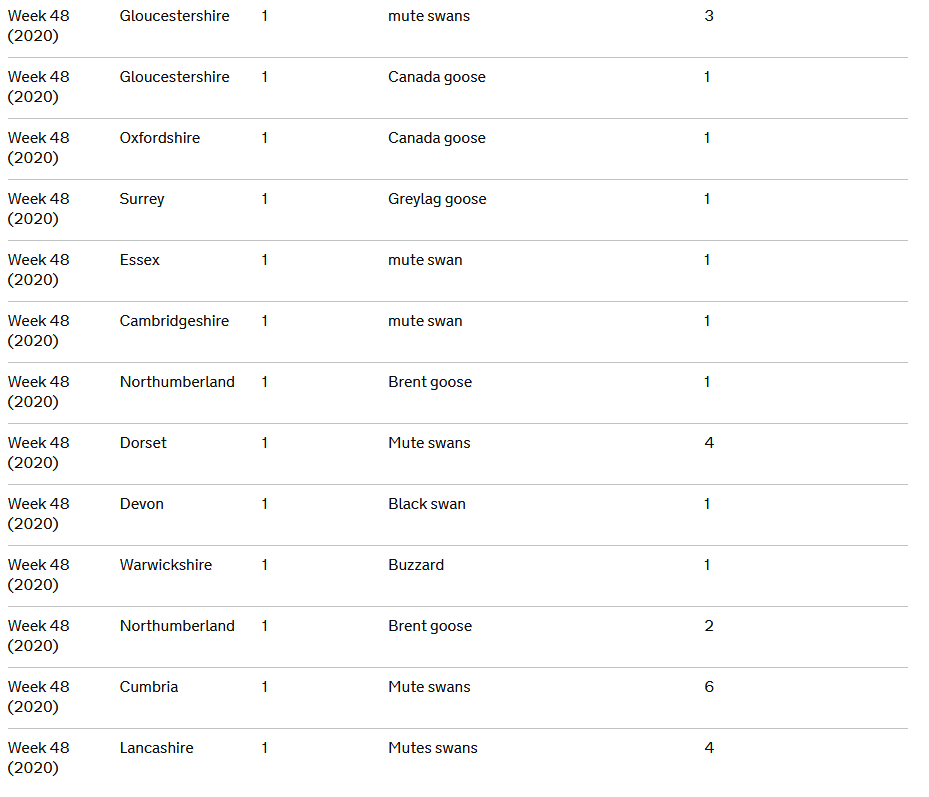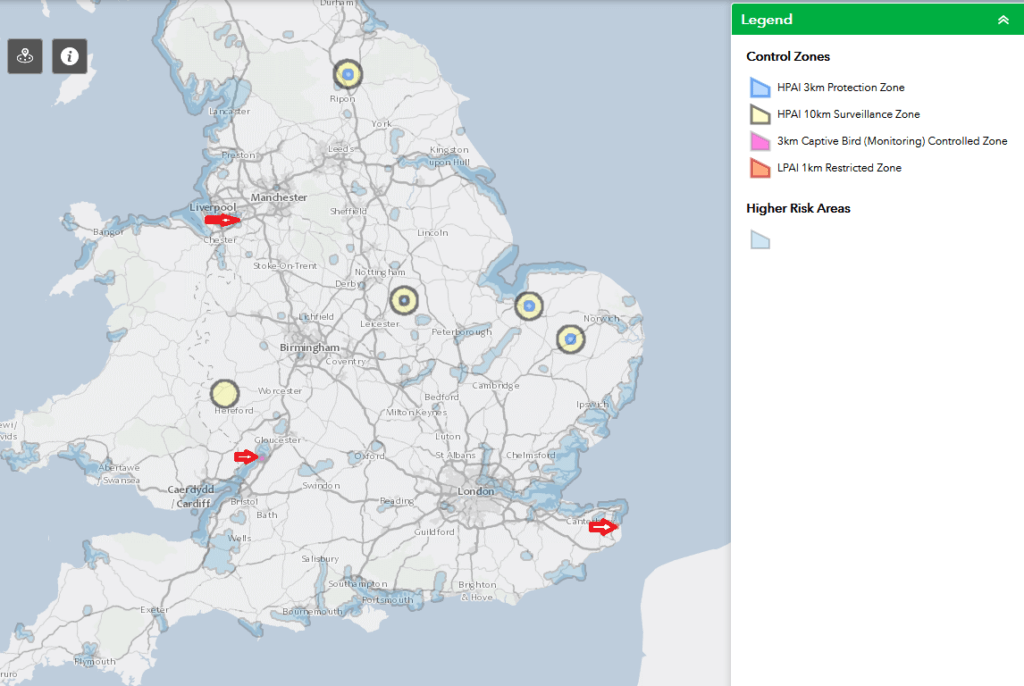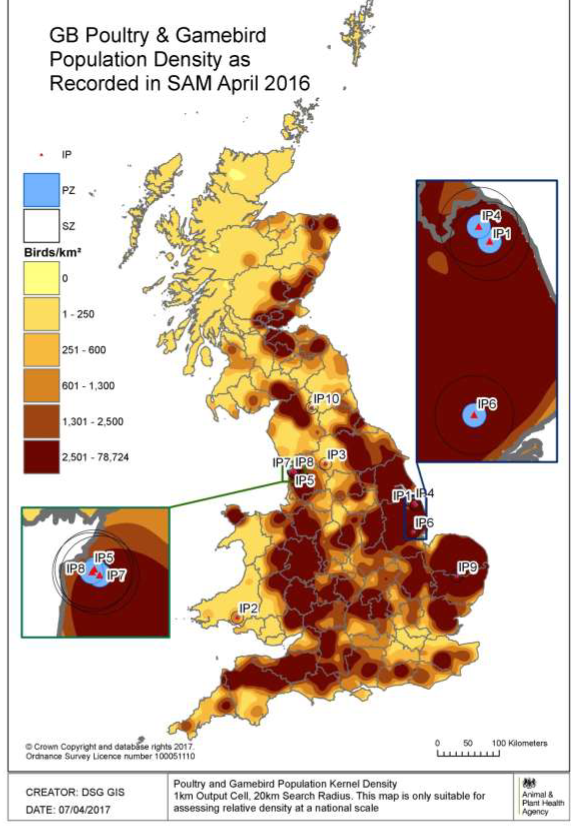A further dozen cases of bird/poultry flu in ‘wild’ birds have been listed by DEFRA for the week which ended on 29 November (which suggests that the wild bird data are getting seriously out of date on the GOV UK website).

This map from APHA shows the poultry farms currently under restrictions: two in Norfolk, two (within the same circle) in North Yorkshire, one in Leicestershire and one in Herefordshire, and I have added the earliest case in Cheshire with a red arrow. I’ve also added the locations of the first avian flu case in Kent this year (but that was of a different strain of the virus) and the location of WWT’s Slimbridge site which has a mixture of captive and wild birds.

The dark blue shaded areas are allegedly areas of Higher Risk – they are simply coastal areas and large inland wetlands (you can spot the Ouse and Nene Washes, Somerset Levels, Cotswold Water Park etc). You can decide for yourself whether the indicated Higher Risk Areas are more related to the poultry outbreaks than you would expect by chance. Quite tricky I’d say.
The case of Slimbridge is interesting. This is a site with hundreds of captive birds living alongside thousands of migratory wildfowl. Many of the captive birds are penned but mostly in open-air pens, ie they aren’t kept indoors in roofed sheds. These captive waterfowl are kept in very different circumstances from those which pertain in commercial poultry farms. When bird/poultry flu hits the UK there are always cases of the H5N8 virus found in wild birds at Slimbridge – probably, I surmise, because there are lots of people there with an interest in wild birds and a workforce well equipped to collect carcases and ship them off for analysis. But the captive birds are not wiped out by bird flu despite being, one would think, very much at risk from all those gulls and wandering geese in the neighbourhood. And yet at a small number of poultry farms, where the birds are kept indoors, far from ‘Higher Risk Areas’ poultry die in large numbers. there must be something to be learned from this although I am not entirely sure what it is. Captive wildfowl at Slimbridge are a bit like low density free-range poultry and are a million miles away from most high-density commercial poultry premises (although not a million miles, not even a mile away from high numbers of potential (and one would expect actual) sources of infection.). I wonder how many free-range poultry enterprises have been hit by poultry flu over the years? What is the per capita risk of a free range chicken compared with one kept indoors througout its life? I’d be very interested to learn the results of that comparison.
Here’s another map – although it isn’t that useful, but all maps are interesting. It’s a map of poultry densities but includes gamebirds (mostly Pheasants and Red-legged Partridges). It’s a few years out of date, but I’m guessing that won’t make much difference. However, the inclusion of gamebirds (which are released in summer and so relatively low numbers are in captivity right now) means that we don’t know much about the distribution of poultry farms from this map (and we learned recently that we can’t trust the gamebird data very much either – see here). It looks very much like a map of Pheasant releases to me.
I have little doubt that wild birds bring H5N8 flu to the UK in most years, but maybe in some years more than others. I’d guess that the virus is swilling around in wild birds everywhere right now. Maybe the Common Gulls that fly over my garden every day have it. And if one annotates the map of poultry outbreaks with the records of dead wild birds that have been tested and were positive for the presence of H5N8 (as I have below) then one finds cases very widely across England. The map is a bit vague as DEFRA only give the counties concerned (which are; Cumbria, Northumberland (those Light-bellied Brents), Lancashire, Staffordshire, Lincolnshire, Norfolk, Suffolk, Cambs, Essex, Warwickshire, Oxon, Gloucestershire, Surrey, Kent, Dorset, Devon and Cornwall).

But as far as I have seen, the impact of this virus on wild bird populations is small – no-one is (as far as I’ve seen) worried about a population-level impact of H5N8 on wild birds, and the relatively low impacts on outdoor bird collections such as Abbotsbury and Slimbridge are interesting.
We seem to be dealing with a disease that is devastating when it gets into highly intensive poultry units but perhaps of little impact otherwise.
As you have seen in the past, I’m interested in bird flu (and we are all interested in viruses these days). How did the virus get into the poultry farm in Herefordshire? There are ‘wild birds’ in Herefordshire, as there are everywhere, but it would be a good candidate for the ‘waterfowl cold spot’ capital of England. What was the chain of events which led to the outbreak there? If we knew, then we’d be better off I suspect.
Each outbreak in a poultry business is a disaster for that business (and not great for the birds either), and let’s see how events develop this winter, but you would need an awful lot of outbreaks to damage the poultry industry and turn this into an important disease economically for the country. I’d be very interested to know more about the biosecurity in place, or missing, in the premises which have been affected over the past decade or so – what have we learned?
Scotland, Wales and Northern Ireland
So far, the only cases I have noticed in these nations are one in a swan (not necessarily, but perfectly feasibly, the species of swan used to illustrate the article) in Northern Ireland.
Elsewhere in the world
France confirmed its first farm outbreak of bird/poultry flu for this winter in a duck farm in Les Landes – 6000 ducks culled. This followed detection of the virus in birds in a pet shop in the north of the country and a small number of cases in wild birds.
Germany – click here.
In Japan more than 2 million chickens have been culled after outbreaks in numerous poultry farms in the south of the country.
[registration_form]

Given the current circumstances that we find ourselves in, you’d have thought that governments would be very keen to learn more about the viruses that are swilling round animal production facilities, and to bring in measures to lessen the risks to human populations.
So, surely there must be government research, white papers etc detailing how they plan to reduce that risk that you can refer to?
Two additional points.
Does DEFRA say how many free range farms get it? If it’s “everywhere” In the wild bird population free range must be many times more vulnerable. Why more occurrences in sheds? (Do Foxes remove any dead free range birds, I know foxes are rated “a problem” by our local free range producer)
I think waterfowl are more susceptible, is that correct? But why Galliformes and not apparently other birds?
Why are there no reports of back garden birds? There are millions of people feeding and watching birds in their gardens..
Are people embarrassed and not reporting a sick bird or DEFRA not investigating it. Small sick birds are difficult to spot in the wild, unlike swans etc but they tend to hang round the feeders looking sick. We have had avian pox and trichomoniasis over time but never anything during a Bird Flu outbreak.
It looks like most effected commercial birds are inside. Its hard to tell from the DEFRA site and I also would like those stats, I think its the same in the US. Our recent bird flu outbreaks have not come as a surprise but have been flagged up by the Russians or others who notice high death rates in the Siberia, Mongolia, China summer grounds. Those birds migrating from other areas don’t seem to be a problem. I’m a frustrated small free range producer about 250 miles north of the present outbreak in December when there is no significant northwards migration. Preparing to keep all birds inside till March.
May – thank you for your first comment here.
Given that all the current evidence points to more likely problems when birds are confined, isn’t it counterintuitive to make all free range keepers of small flocks confine them in houses that are not designed to keep them in 24/7!
I am in carlisle and have only 3 chickens in a shed, do I need to keep them inside, are they at risk. I do let them free during the day.
Same here in the highlands